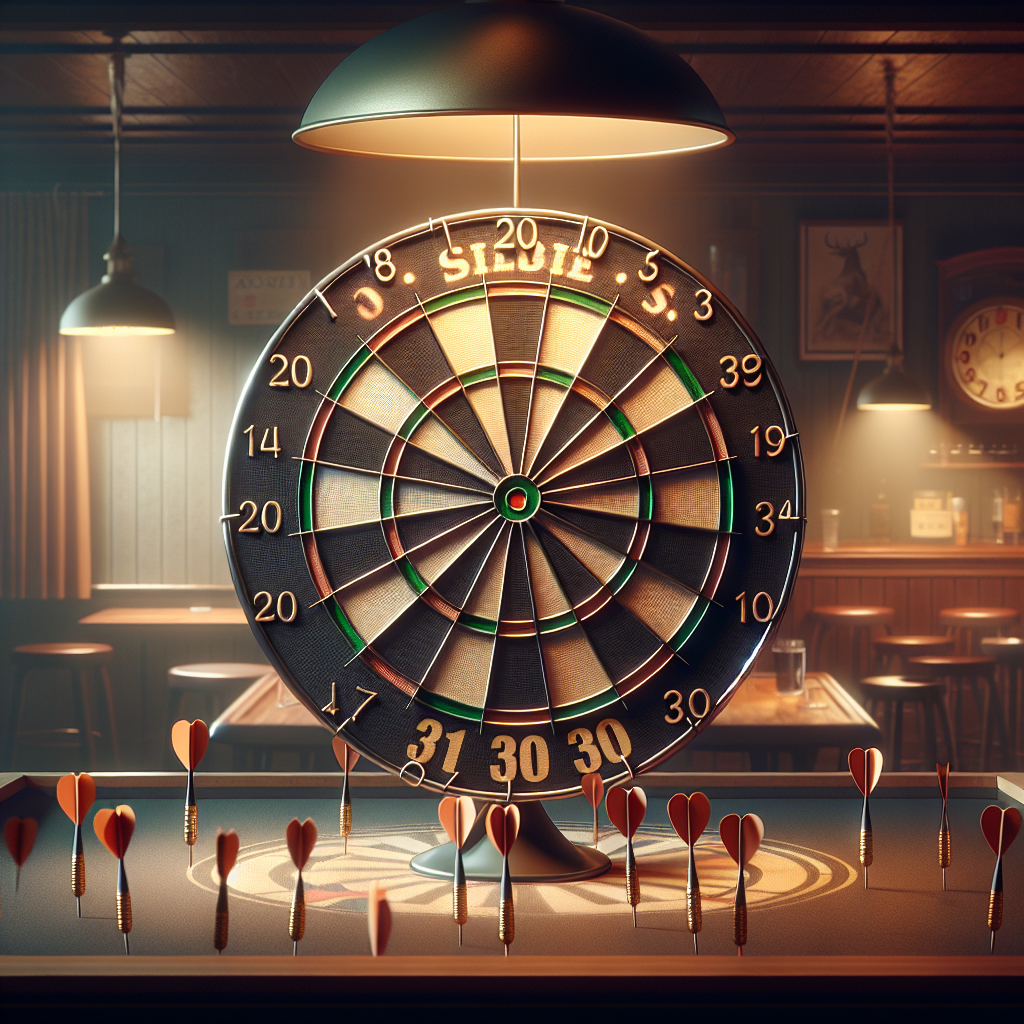Understanding Dart Games
Dart games have been enjoyed by adults around the world for many years. Whether played casually at home or in competitive tournaments, these games require skill, accuracy, and a steady hand. In this section, we will provide an introduction to dart games and explore some popular variations.
Introduction to Dart Games
Dart games are played using a dartboard and a set of darts. The objective is to score points by throwing the darts at specific areas on the board. The most well-known and widely played game in the world of darts is 501. However, its most common variation is 301. 301 darts offers new players an easier and quicker version of the game compared to its more popular counterpart, 501 (Dart Help).
Popular Dart Game Variations
In addition to 301 and 501, there are several other popular dart game variations that provide unique challenges and rules. Some of these variations include:
- Cricket: A strategic game that involves hitting specific numbers on the dartboard to score points and “close” those numbers.
- Baseball: A game that mimics the scoring system of baseball, where players aim to hit different sections of the dartboard to advance runners and score runs.
- Around the Clock: A game that requires players to hit each number on the dartboard in sequential order, starting from 1 and ending at 20.
These are just a few examples of the many dart game variations available. Whether you prefer traditional games or newer electronic dart games, there is a wide variety of options to choose from (Dart Help). Dart games can be enjoyed in different settings, such as bars, arcades, or even in the comfort of your own home.
By familiarizing yourself with the rules and variations of dart games, you can enhance your dart-playing experience and challenge yourself to improve your skills. Whether you’re playing casually with friends or competing in an official tournament, dart games provide endless entertainment for dart enthusiasts of all levels.
Mastering 301 Dart Game
In order to become proficient in the 301 dart game, it’s essential to understand the objective and setup, scoring rules, and the key to winning the game.
Objective and Setup
The objective of the 301 dart game is to be the first player to reduce their score to zero. Each player starts with a base score of 301 points and takes turns throwing their darts. The main goal is to subtract the total points thrown from the starting score of 301. The player who reaches zero first is declared the winner.
To set up the game, you will need a standard-size dartboard with a diameter of 18 inches. The game can be played by two to four players. For singles play, two teams of two players each can participate. The equipment required includes steel-tip darts or soft-tip darts, depending on the type of dartboard being used. The distance to throw from can vary, with the standard distance being 7 feet 9.25 inches for steel-tip darts and 8 feet for soft-tip darts. However, for beginners, the distance can be adjusted to make the game more approachable.
Scoring in 301 Darts
In the 301 dart game, the score for each turn is determined by the numbers hit on the dartboard. The scoring system is as follows:
- Hitting a single segment of any number scores the face value of that number.
- Hitting the outer narrow ring (double) of any number doubles the face value of that number.
- Hitting the inner narrow ring (triple) of any number triples the face value of that number.
- Hitting the bullseye in the center of the board scores 50 points, while hitting the outer bullseye ring scores 25 points.
Players take turns throwing three darts each, subtracting their total points thrown from their current score. It’s important to note that the score cannot go below zero. If a player’s turn would result in a negative score, their score remains the same as the previous round’s score (Dart Help).
Winning the Game
The game of 301 darts ends when one player reaches exactly zero points. To win, a player must hit zero exactly, and the final dart must land in a double segment. This is known as the “double out” rule. If a player’s score goes below zero or they fail to hit a double with their final dart, their turn ends, and they continue in the next round with the same score they had before their turn.
In official tournament play, the double out rule is strictly enforced. However, in friendly competitions, players may choose not to enforce this rule, allowing for a single or any other segment to end the game. It is important to establish the rules and clarify them before starting a game to avoid any confusion or disagreements (Billiards Direct).
By understanding the objective and setup, scoring rules, and the requirements for winning the game, you can start mastering the 301 dart game. Remember to practice your aim, strategize your throws, and aim for that perfect double to secure victory.
Advanced Strategies in 301 Darts
To excel in the game of 301 darts, players can employ advanced strategies that focus on perfect aim, scoring techniques, understanding the double out rule, and strategic finishing.
Perfect Aim and Scoring
One of the key elements to master in 301 darts is achieving perfect aim and maximizing scoring opportunities. Professional players often aim to leave themselves with repeatably bisectable numbers, such as 24 or 32 (double 16), to ensure an advantage in scoring. This strategy allows players to reduce their score to an even number without needing to throw extra darts.
Additionally, it’s important to be aware of the different scoring areas on the dartboard. Hitting higher-value areas like the triple ring (worth three times the segment’s value) or the bullseye (worth 50 points) can significantly boost your score and help you reach zero more efficiently.
Double Out Rule
In 301 darts, players must adhere to the “double out” rule to win the game. This means that to finish the game, a player must hit a double that brings their score precisely to zero. If a player goes over the required total, it results in a bust and the end of their turn.
It’s important to note that the double out rule may vary between official tournament play and casual competitions. In official tournaments, players must hit a double with their last throw to win the game; otherwise, their turn ends. However, in more casual settings, this rule may not be strictly enforced.
Strategic Finishing
Strategic finishing is another aspect of advanced gameplay in 301 darts. When approaching the final stages of the game, players aim to finish with a double. By doing so, they leave themselves with a better chance of successfully reaching zero and winning the game.
For example, if a player has a score of 32 remaining, they may choose to aim for the double 16. If successful, their score will be reduced to zero. This strategy ensures that players have a clear path to victory without relying on additional darts.
In some cases where players reduce their score to 1, an unofficial rule called “splitting the 11” can be employed. This rule requires the player to throw a dart between the two numbers that form the number 11 on the edge of the dartboard, providing a challenging yet strategic opportunity to finish the game.
By incorporating these advanced strategies into your gameplay, you can enhance your performance in 301 darts. Perfecting your aim, understanding the double out rule, and employing strategic finishing techniques will elevate your game and increase your chances of securing victory.
Variants of 301 Dart Game
While the standard 301 dart game provides an exciting challenge, there are also several variants that add unique twists to the gameplay. Let’s explore some of these variants: 301 Elimination Dart, Double Out Variant, and Tag Team Variation.
301 Elimination Dart
The most well-known variant of the 301 dart game is the 301 Elimination Dart. This variant follows the basic rules of a regular 01 dart game, where players aim to reach zero from a starting score of 301. However, in the elimination version, players have the option to eliminate opponents by setting their points to zero (myDartpfeil).
In this variant, the game starts at 301, and the player who either scores exactly 301 first or has the highest score after several predetermined rounds emerges as the winner. The strategic element comes into play when a player scores the exact number of points that another player currently has on their scoreboard, causing the opponent’s points to reset to zero (myDartpfeil). This strategic twist adds complexity and interest to the game, requiring players to play tactically and effectively eliminate opponents.
Double Out Variant
Another variant of the 301 dart game is the Double Out Variant. In this version, players can only win the game by hitting a double on their final dart. This means that once a player’s score reaches 2 or less, they must hit a double to reach exactly zero and win the game.
The double out rule adds an extra level of difficulty and strategy to the game, as players must carefully plan their shots and aim for the doubles. It requires precision and skill to successfully finish the game with a double, making each throw even more crucial.
Tag Team Variation
If you’re looking to add a collaborative element to the game, the Tag Team Variation is an excellent choice. In this variant, players can team up and play together as a team. This adds a new dynamic to the game, as players can strategize and work together to achieve victory.
In a Tag Team game, players have the option to play with two points or four points in team matches, allowing for flexibility in gameplay. This variation fosters teamwork, communication, and coordination among players, making it a fun and engaging option for groups of friends or dart enthusiasts looking for a different kind of challenge.
By exploring these variants of the 301 dart game, you can add excitement and variety to your dart sessions. Whether you choose the elimination variant, the double out rule, or the tag team variation, these alternatives offer a fresh take on the classic 301 game and provide new opportunities for strategic play and friendly competition.
Tournament vs. Casual Play
When it comes to playing the 301 dart game, there are different approaches depending on whether you’re participating in an official tournament or engaging in a friendly competition. Understanding the distinctions between these two settings can help you navigate the game effectively.
Official Tournament Rules
In official tournament play, the rules for the 301 dart game are more stringent. The objective remains the same: to reach zero points as quickly as possible. However, there is an additional requirement to win the game. According to official tournament rules, players must hit a double with their last throw to reach zero and win the game. If the double is not hit, the turn is over (Sports Boom).
These rules are designed to add an extra layer of challenge and skill to the game. Requiring a double to finish the game tests a player’s accuracy and consistency under pressure. It also ensures that players cannot simply rely on luck to win. However, it’s important to note that some specific tournaments or leagues may have variations in their rules, so always check the specific regulations for the competition you are participating in.
Friendly Competition Guidelines
In more casual settings, such as friendly matches or non-official competitions, the rules for the 301 dart game may be more flexible. While the objective of reaching zero points remains the same, the requirement to hit a double with the last throw to win the game is often not enforced. This relaxed approach allows players to focus more on the enjoyment of the game and may be preferred in social gatherings or informal matches.
In these friendly competitions, players may choose to adopt their own set of rules or modify existing ones to suit their preferences. This flexibility can make the game more accessible and enjoyable for players of different skill levels. However, it’s always important to establish clear guidelines and ensure that all players are aware of the agreed-upon rules before starting the game.
Whether you’re participating in an official tournament or engaging in a friendly competition, the 301 dart game offers an exciting challenge for dart enthusiasts. By understanding the variations in rules and guidelines, you can adapt your strategies and approach accordingly. Remember to always respect the rules and guidelines set by the specific competition or agreement between players, and most importantly, have fun while honing your dart skills.
Equipment and Setup
Before diving into the exciting world of 301 Dart Game, it’s essential to familiarize yourself with the necessary equipment and setup. This section will cover the players and teams, the dartboard and distance, and the necessary equipment for playing the game.
Players and Teams
The game of 301 Darts is suitable for 2 to 4 players. In singles play, there are typically two teams of two players each. However, if you prefer a more casual game, you can also play individually. Having multiple players adds an element of competition and camaraderie to the game (Billiards Direct).
Dartboard and Distance
The most commonly used dartboard for playing 301 Darts is the “clock” or “trebles” board. This design consists of a circle divided into 20 segments, numbered from 1 to 20, with each segment having a different point value. The board also features a bullseye, which is divided into an outer and inner ring. The outer bullseye is worth 25 points, while the inner bullseye, also known as the “double bull,” is worth 50 points (Masters of Games).
To set up the dartboard, ensure that it is securely mounted on a wall or a dartboard stand. The standard height for the center of the bullseye is 5 feet 8 inches (1.73 meters) from the floor. For younger players or beginners, it may be appropriate to adjust the height accordingly.
Regarding the throwing distance, players should stand at a distance of 7 feet 9.25 inches (2.37 meters) from the face of the dartboard. This measurement is commonly referred to as the “oche” or “throw line.” Mark the line on the floor to ensure consistent positioning during the game.
Necessary Equipment
To play 301 Darts, you will need a few essential pieces of equipment. The first requirement is a set of darts. You can choose between steel-tip darts or soft-tip darts, depending on the type of dartboard you have. Steel-tip darts are used with traditional bristle dartboards, while soft-tip darts are used with electronic dartboards.
It’s important to select darts that feel comfortable in your hand and suit your throwing style. Experiment with different weights and barrel designs to find the darts that work best for you. Additionally, having spare flights and shafts on hand is a good idea, as these components can wear out over time.
Lastly, you will need a dartboard. The standard size for a dartboard is 18 inches (45.72 centimeters) in diameter. However, larger dartboards are available for beginners or players who prefer a larger target area. Ensure that the dartboard is in good condition, with no excessive wear or damage to the playing surface.
By understanding the equipment and setup required for 301 Dart Game, you are ready to embark on an exciting journey of precision and strategy. Gather your friends, set up the dartboard, and let the game begin! For more information on the rules and strategies of 301 Darts, continue reading the rest of our article.







